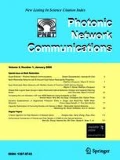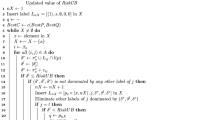Abstract
Path protection is a fast and capacity-efficient approach for increasing the availability of end-to-end connections. However, sometimes it is not possible to obtain a fully disjoint path pair. In this case, it may be admissible to consider a path pair which is as disjoint as possible, and thus provide the best (in a certain sense) level of the single-fault protection that can be ensured using this type of approach. A shared risk link group (SRLG) is a group of links which have a common risk of failure. Two new heuristics for solving the min-sum maximally node and SRLG-disjoint path pair are presented. The relative performance of the new heuristics and also of two other previously proposed heuristics is evaluated using four different networks. Results, regarding accuracy and execution time of the studied heuristics, show that one of the new proposed algorithms can be a good compromise for use in the Generalized Multi-protocol Label Switching control plane.


Similar content being viewed by others
References
IBM ILOG CPLEX Optimization Studio V12.5. IBM (2012)
Awduche, D., Berger, L., Gan, D., Li, T., Srinivasan, V., Swallow, G.: RSVP-TE: extensions to RSVP for LSP tunnels. IETF RFC 3209 (2001)
Bhandari, R.: Survivable Networks, Algorithms for Diverse Routing. Kluwer Academic Publishers, Norwell, Massachusetts (1999)
Cheng, X., Shao, X., Wang, Y.: Multiple link failure recovery in survivable optical networks. Photonic Netw. Commun. 14, 159–164 (2007)
Farrel, A., Vasseur, J.P., Ash, J.: A path computation element (PCE)-based architecture. ITEF RFC 4655 (2006)
Gao, C., Zhu, Y., Jue, J.: SRLG-aware topology aggregation for survivable multi-domain optical networks. In: 2011 IEEE International Conference on Communications (ICC), pp. 1–5 (2011). doi:10.1109/icc.2011.5963224
Gomes, T., Fernandes, L.: Obtaining a SRLG-disjoint path pair of min-sum cost. In: Rak, J., Tipper, D., Walkowiak, K. (eds.) RNDM 2010–2nd International Workshop on Reliable Networks Design and Modeling, Colocated with ICUMT 2010, pp. 116–122. ISBN: 978-I-4244-7283-3. Moscow (2010)
Gomes, T., Jorge, L., Melo, P., Girão-Silva, R., Mendes, S.: Calculating a maximally node and SRLG-disjoint path pair of min-sum cost in GMPLS networks. In: 9th International Conference on Design of Reliable Communication Networks—DRCN 2013, pp. 314–321. Budapest, Hungary (2013)
Gomes, T., Simões, C., Fernandes, L.: Resilient routing in optical networks using SRLG-disjoint path pairs of min-sum cost. Telecommun. Syst. J., 1–13 (2011). doi:10.1007/s11235-011-9574-5
Hu, J.Q.: Diverse routing in optical mesh networks. IEEE Trans. Commun. 51(3), 489–494 (2003)
Luo, H., Li, L., Yu, H.: Insights for segment protection in survivable WDM mesh networks with SRLG constraints. Photonic Netw. Commun. 14, 361–368 (2007)
Mannie, E.: Generalized multi-protocol label switching (GMPLS) architecture, IETF RFC 3945 (2004)
Marler, R., Arora, J.: Survey of multi-objective optimization methods for engineering. Struct. Multidiscip. Optim. 26(6), 369–395 (2004). doi:10.1007/s00158-003-0368-6
Mendonça, J., Naser, H.: Class of service with partial protection in multilayered networks with SRLG constraints. In: Proceedings of the IEEE Symposium on Computers and Communications (ISCC’10), pp. 279–284. Riccione, Italy (2010)
Oki, E., Matsuura, N., Shiomoto, K., Yamanaka, N.: A disjoint path selection scheme with shared risk link groups in GMPLS networks. IEEE Commun. Lett. 6(9), 406–408 (2002)
Orlowski, S., Pióro, M., Tomaszewski, A., Wessäly, R.: SNDlib 1.0-survivable network design library. Networks 55(3), 276–286 (2010). doi:10.1002/net.20371
Palmieri, F.: GMPLS control plane services in the next-generation optical Internet. Internet Protoc. J. 11(3), 2–18 (2008)
Pan, X., Xiao, G.: Heuristics for diverse routing in wavelength-routed networks with shared risk link groups. Photonic Netw. Commun. 11, 29–38 (2006)
Rostami, M.J., Khorsandi, S., Khodaparast, A.A.: CoSE: A SRLG-disjoint routing algorithm. In: Proceedings of the Fourth European Conference on Universal Multiservice Networks (ECUMN’07). Toulouse, France (2007)
Rostami, M.J., Zarandi, A.A.E., Hoseininasab, S.M.: MSDP with ACO: a maximal SRLG disjoint routing algorithm based on ant colony optimization. J. Netw. Comput. Appl. 35, 394–402 (2012)
Shao, X., Xiao, G., Zhou, L., Cheng, X., Wang, Y.: Hybrid protection in WDM networks with shared risk link groups. Photonic Netw. Commun. 12, 295–307 (2006)
Sheela, D., Chellamuthu, C.: A cost effective approach for WDM network protection under critical duct constraints. WSEAS Trans. Commun. 11(3), 103–112 (2012)
Silva, J., Gomes, T.M., Fernandes, L., Simões, C., Craveirinha, J.: An heuristic for maximally SRLG-disjoint path pairs calculation. In: 3rd International Congress on Ultra Modern Telecommunications and Control Systems (ICUMT 2011 Budapest). Budapest, Hungary (2011)
Todimala, A., Ramamurthy, B.: IMSH: An iterative heuristic for SRLG diverse routing in WDM mesh networks. In: 13th International Conference on Computer Communications and Networks, ICCCN’2004, pp. 199–204 (2004). doi:10.1109/ICCCN.2004.1401627
Wang, S., Li, L.: Impairment aware optimal diverse routing for survivable optical networks. Photonic Netw. Commun. 13, 139–154 (2007)
Xu, D., Li, G., Ramamurthy, B., Chiu, A., Wang, D., Doverspike, R.: On provisioning diverse circuits in heterogeneous multi-layer optical networks. Comput. Commun. 36(6), 689–697 (2013). doi:10.1016/j.comcom.2012.08.014. Reliable Network-based Services
Xu, D., Xiong, Y., Qiao, C.: Novel algorithms for shared segment protection. IEEE J. Sel. Areas Commun. 21(8), 1320–1331 (2003)
Xu, D., Xiong, Y., Qiao, C., Li, G.: Trap avoidance and protection schemes in networks with shared risk link groups. J. Lightw. Technol. 21(11), 2683–2693 (2003)
Yan, W., Junhui, Z., Jiazhi, Z.: New SRLG-diverse path selection algorithm in survivable GMPLS networks. J. Syst. Eng. Electron. 20(2), 412–419 (2009)
Zhang, F., Li, D., de Dios, O.G., Margaria, C.: RSVP-TE extensions for collecting SRLG information. IETF Draft (2014)
Acknowledgments
We thank Sérgio Mendes for implementing part of the code used in this work. The authors acknowledge financial support through project QREN 23301 PANORAMA II, co-financed by European Union’s FEDER through “Programa Operacional Factores de Competitividade” (POFC) of QREN (FCOMP-01-0202-FEDER-023301), by the Portuguese Foundation for Science and Technology under project grant UID/MULTI/00308/2013 and by PT Inovação R&D Project “End to End Protection considering SRLGs-II”.
Author information
Authors and Affiliations
Corresponding author
Appendix: illustrative example
Appendix: illustrative example
This appendix will try to clarify the main differences between the considered heuristics. The network which will be used in this example is in Fig. 3a, where the ellipses represent different SRLGs and the arcs in dashed red represent the shortest path from s to t. Let the SRLGs be \(A_1 =\{(a,b), (a,d), (b,a)\}\), \(A_2=\{(b,t), (c,t)\}\) and \(A_3=\{(c,t), (d,t),(t,d)\}\).
The initial path pair obtained by the four considered heuristics is the same: The maximally node-disjoint path pair of min-sum cost is shown in Fig. 3b where the arcs in dashed red are from the shortest path; also note that arc (s, a) is shared by both paths. This initial solution has a minimal cost of 15 (corresponding to 8+7), where the cost of arc (s, a) is counted in both paths, and this path pair has two SRLGs in common. This is the initial solution, and the algorithms will seek to improve.
After calculating the seed path \(\langle s,a,b,c,t \rangle \), the network is modified, as illustrated in Fig. 4a, b for MBHE and MSHE, respectively.
The maximally node-disjoint path pair of min-sum cost is not SRLG-disjoint, and hence, algorithm IMSH will sequentially generate paths until \(i_{\max }\) is reached (or no more paths exists), by non-decreasing cost, using each of them as a seed path in the MSHE, seeking to obtain a maximally node and SRLG-disjoint path pair. In this example, the used k-shortest path enumeration algorithm will generate five paths, and the best solution (path pair \((\langle s,a,b,t\rangle ,\langle s,a,d,t\rangle )\) of cost 19) will be obtained using the third shortest path \(\langle s,a,b,t \rangle \) as seed path.
MdWSRLG will always use MBHE in each iteration, because the seed path is always the shortest path (in the network where the costs have been modified)—note that MBHE tends to obtain path pairs with smaller cost than MSHE. MdWSRLG will change the cost of the edges according to Eq. (6), increasing the importance of the original link cost. In the case of the network in the example, the optimal solution is found with \(\alpha = 0.5\), but the algorithm will keep trying to improve this solution, until the convergence condition for \(\alpha \) is met.
Algorithm MdCoSE-MS starts by using MBHE with seed path \(\langle s,a,b,c,t \rangle \), obtaining the maximally disjoint path pair of Fig. 3b. The set of common SRLGs is \(\{A_1,A2\}\). The conflicting SRLG set will be \(\{A_2\}\), because \(\{A_1\}\) is the critical SRLG set (if the links in \(A_1\) are removed, no seed path can be found). The algorithm will then remove the arcs in \(A_2\) from the network before calculating a new seed path—the goal is to obtain a seed path that does not use the SRLG(s) that was (were) common to the previously obtained path pair. These arcs are re-inserted in the network before calling MSHE with seed path \(\langle s,a,d,t \rangle \), resulting in the optimal path pair. As the set of common SRLGs of that path pair is \(\{A_1\}\) (the critical SRLG set), the algorithm ends.
Algorithm MdTA first identifies \(\{(s,a)\}\) the critical arc set (see line 4 of algorithm MdTA). MSHE, with seed path \(\langle s,a,b,c,t \rangle \), will obtain the path pair in Fig. 3b. Then, the most risky arc (see function MostRiskyArc), that is the arc in the seed path considered responsible for MSHE not being able to find a node and SRLG-disjoint path (excluding arc (s, a)), will be selected. In this example, the candidates for most risky arc are (c, t) and (a, b), where (c, t) is selected because in the case of a tie the arc with the tail node with highest out-degree is chosen. This tends to increase the probability of being able to calculate seed paths in the successively pruned network. Removing arc (c, t) will result in the seed path \(\langle s,a,b,t \rangle \); after reinserting (c, t) MSHE with seed path \(\langle s,a,b,t \rangle \) will obtain the path pair (\(\langle s,a,b,t \rangle , \langle s,a,d,t \rangle )\), which is the optimal solution. However, because it is not an SRLG-disjoint path pair, the algorithm will try to improve this solution. The next most risky arc will be (a, b), followed by (a, d), and then the algorithm will end with the best-found solution, because it will no longer be able to calculate a seed path.
Rights and permissions
About this article
Cite this article
Gomes, T., Jorge, L., Melo, P. et al. Maximally node and SRLG-disjoint path pair of min-sum cost in GMPLS networks: a lexicographic approach. Photon Netw Commun 31, 11–22 (2016). https://doi.org/10.1007/s11107-015-0524-0
Received:
Accepted:
Published:
Issue Date:
DOI: https://doi.org/10.1007/s11107-015-0524-0






